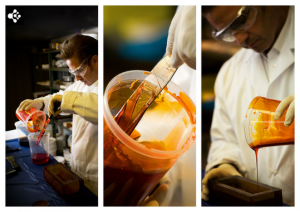Are you a beginner or an expert in the art of using a thermosetting resin? Here are some tips for a successful result.

Thermosetting resins are getting more and more popular. Their interesting properties in terms of electrical, mechanical, chemical and thermal resistance have contributed to the development of multiple applications in a variety of sector : from casting, prototyping, potting electronic parts, to artistic achievements, etc. No matter what kind of resin you use, polyurethane, silicone or epoxy, do not make these too frequent mistakes.
1. You do not use the right formula for your application
Each resin has its own characteristics. Your choice of resin must be adapted to your specific needs. For instance polyurethane systems are usually excellent for mold making when high resistance to abrasion or shocks is required , as it is the case in the construction industry. On the other hand, silicone-based products are better indicated for precision molds.
2. You do not measure correctly the ratio for Part A (Resin) and Part B (Hardener)
Polymerization reaction will not happen correctly if the specific ratio of part A (resin) and part B (hardener) is not strictly mesured. If you do not folow the instructions properly, your might experience problems and bad results.
3. You mix to much quantity of product for your available working time .
Estimate the right quantities to be mix according to 1 ) the “pot life ” of your product & 2 ) the working time needed. If you need to apply more than one layer of resin on a large surface, be careful not to mix too much product in advance.
4. You do not bother about your work environment (temperature) and storage conditions of your resin.
A 22 degrees Celsius environment is always indicated for working your resin or storing your resin containers. Any variation in temperature will modify the “pot life” and the cure time indicated on the technical data sheet. When stored in lower temperatures, the resin has a higher viscosity, higher pot life , longer cure time. On the opposite, with a temperature above 22 degrees celsius, viscosity is lower, “pot life” is shorthened, resin cures faster.
5. Part A (resin) and Part B (hardener) are not mix thoroughly
Strictly mesure and mix part A and B according to the ratio indicated in the technical data sheet. Part A and Part B shall be stirred separetly before mixing them together. Make sure the mixture is perfectly homogenous, scraping the bottom and the sides of the containers. If you do not mix thoroughly, polymerization will not be completed. As a result, the product might remain soft or sticky (However, do not stir to vigorously in order to minimize the formation of air bubbles).
If you have questions concerning the use of our resin, ask our technical experts : [email protected]

